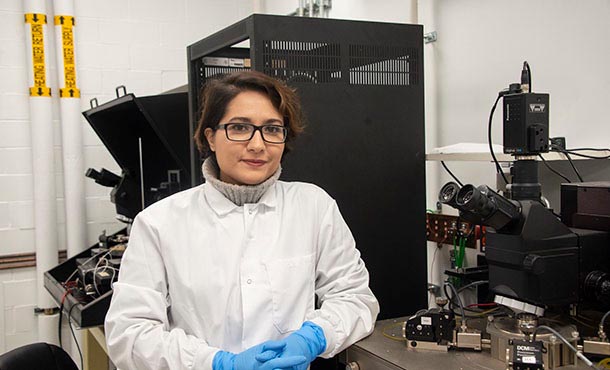
Aida Ebrahimi, assistant professor of electrical engineering in the Penn State School of Electrical Engineering and Computer Science. IMAGE: PENN STATE COLLEGE OF ENGINEERING
New bacterial testing method to improve health care, food safety and more
11/2/2020
By Sarah Small
UNIVERSITY PARK, Pa. — Detecting viable bacteria is important for various fields, from food safety to medical diagnosis. The existing techniques to conduct antibiotic susceptibility testing (AST) — testing that, for example, allows health care providers to prescribe the correct dose of antibiotics for a particular infection — are slow, require skilled personnel or utilize bulky and expensive instruments. A new electrochemical sensor developed by Penn State researchers now can make that process simpler, while being low-cost and portable, and can directly monitor viable bacteria in liquid samples such as blood or milk.
“Blood is a very complex solution,” said Aida Ebrahimi, assistant professor of electrical engineering in Penn State’s School of Electrical Engineering and Computer Science. “It has various components, including red blood cells and many proteins, which make detection of specific targets, such as live bacterial cells, very difficult. It is also optically opaque, which makes it challenging for optical methods to directly analyze blood.”
In contrast, electrochemical sensors are not limited by sample opacity. However, the existing electrochemical methods for measuring bacterial viability require mixing a redox-active reagent with the sample. The redox-active reagent exchanges electrons with metabolizing cells. However, one issue is that this reagent can interfere with the antibiotics. Moreover, the addition of these reagents limits the application of the sensors for detecting live bacteria, for example in food screening. The new method developed by the Ebrahimi group does not require any additional agent.
“We developed a redox-active crystal, called RZx, using a simple electrodeposition method which only uses organic components,” Ebrahimi said. “The process to create the material is very low cost and is done at room temperature and neutral pH — not acidic or alkaline — making it very safe and environmentally friendly. The organic crystal enables direct detection of bacterial metabolic activity by sensing the pH changes due to cell respiration as well as detecting small molecules released by metabolizing — alive — cells.”
The researchers also showed the versatility of the sensor manufacturing process by depositing RZx on a variety of electrodes, from screen-printed carbon electrodes on paper to laser induced graphene electrodes created using a CO2 laser writing system. This ability to design and manufacture arbitrary geometries is important for scalable production and device engineering.
While Ebrahimi’s team recently has made other developments for rapid AST, the RZx-based sensors are portable. Also, in their previous research, they looked at the movement of bacteria, whereas here, they are probing cell metabolic activity. This is advantageous because sometimes bacteria may not be moving while still metabolizing, or “breathing.”
Ebrahimi also noted that this method could be used not only in medical diagnosis but also to test food quality. In addition to testing blood, the researchers tested milk samples, as testing for live bacteria is important in food safety and quality checks. The same principle can also be applied to testing water for environmental safety and monitoring.
Beyond these works, Ebrahimi is also looking at future applications for this method.
“For the future, we are looking into expanding the work to analyze other microbial pathogens, such as fungi, as well as applications beyond AST, especially for smart wound dressing or smart catheters, as bacterial infections in both of these areas are big problems,” she said.
The paper that discusses these results, “Organic redox-active crystalline layers for reagent-free electrochemical antibiotic susceptibility testing (ORACLE-AST),” was recently published in the journal Biosensors and Bioelectronics. The other authors, all of Penn State, are Adam Bolotsky, a graduate student in materials science and engineering; electrical engineering graduate students Ritvik Muralidharan, Derrick Butler and William Murray; Kayla Root, an undergraduate in biochemistry and molecular biology; and Zhiwen Liu, professor of electrical engineering.
This work was partially supported by the Penn State Materials-Life Science Convergence Award, the College of Engineering Multidisciplinary Research Seed Grant and Ebrahimi’s faculty startup fund.



